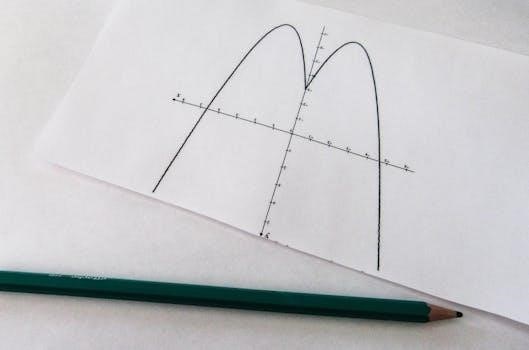
illustrative mathematics algebra 2 answer key pdf
Illustrative Mathematics Algebra 2 Answer Key PDF⁚ A Comprehensive Guide
Welcome to your comprehensive guide that unlocks the solutions and insights into the Illustrative Mathematics Algebra 2 curriculum! This resource offers clarity and support, ensuring effective learning and deeper understanding of algebraic concepts. It provides tools for success, including answers and reasoning.
Embark on a journey through Algebra 2 with Illustrative Mathematics, a curriculum designed to foster reasoning, problem-solving, and a deeper understanding of mathematical concepts. This course builds upon previous knowledge, extending exponent rules and exploring complex numbers. It delves into sequences, polynomials, and rational functions, connecting these abstract ideas to real-world applications. With a focus on patterns, generalizations, and the interpretation of solutions, Illustrative Mathematics encourages students to explain their reasoning verbally and in writing. This approach promotes active learning, critical thinking, and the ability to evaluate the reasonableness of answers. The curriculum integrates the use of technology, such as Desmos, to visualize and explore mathematical relationships. By rewriting expressions in different ways, students discover new insights and connect mathematical concepts to various contexts. The problem-based core challenges them to brainstorm possible strategies, fostering collaboration and communication. The ultimate goal is to equip students with the skills and knowledge to succeed in future mathematical endeavors and appreciate the beauty and power of algebra.

Understanding the Structure of Illustrative Mathematics Curriculum
The Illustrative Mathematics Algebra 2 curriculum is thoughtfully structured to guide students through a coherent and progressive learning experience. Each unit builds upon previous concepts, fostering a deep understanding of algebraic principles. The curriculum emphasizes problem-solving, reasoning, and the application of mathematical knowledge to real-world scenarios. Lessons are designed to encourage active participation, with opportunities for students to explore, discover, and explain their thinking. The curriculum incorporates various representations, including algebraic expressions, graphs, and tables, to cater to different learning styles. It also promotes collaboration and communication through group activities and discussions; The structure integrates technology, allowing for dynamic exploration and visualization of mathematical concepts. The curriculum’s design optimizes student output by encouraging detailed explanations. It maximizes meta-awareness, prompting reflection on the reasoning process. Moreover, it supports sense-making through clear connections between language and problem-solving. The curriculum prioritizes accessibility with appropriate accommodations for diverse learners. The Illustrative Mathematics Algebra 2 curriculum provides a robust framework for developing mathematical fluency and a lifelong appreciation for the power of algebraic thinking.

Accessing the Algebra 2 Answer Key PDF
Obtaining the Algebra 2 Answer Key PDF for the Illustrative Mathematics curriculum involves specific procedures. Access is typically granted through official channels or certified partners. One should consult Illustrative Mathematics certified partners to ensure authorized and accurate resources. These partners provide comprehensive access to materials, including answer keys, supporting effective teaching and learning. The Illustrative Mathematics website may offer guidance on accessing these resources. Educators often gain access through school subscriptions or district-provided materials. It’s crucial to verify the source’s legitimacy to avoid inaccurate or incomplete answer keys. The answer keys are designed as supplemental tools, aiding teachers in assessing student understanding and guiding instruction. They enable efficient review and provide insights into problem-solving strategies. Remember, these keys should be used responsibly to enhance learning, not to replace critical thinking and problem-solving. For full sampling or purchase, contacting an IM Certified Partner is the recommended step. These materials are designed to support instruction and promote a deeper understanding of Algebra 2 concepts. They provide a reference for educators to ensure accurate assessment and effective feedback.

Unit-Specific Answer Keys and Solutions
The Illustrative Mathematics Algebra 2 curriculum is structured into distinct units, each addressing specific mathematical concepts. To effectively support learning, unit-specific answer keys and detailed solutions are provided. These resources are crucial for both students and educators. They allow for targeted assessment and focused instruction. Each unit’s answer key offers step-by-step solutions, clarifying the problem-solving process. For example, in Unit 1, which focuses on sequences, the answer key provides detailed explanations for identifying geometric and arithmetic sequences. These solutions guide students through the reasoning and application of relevant mathematical principles. Unit 2, and subsequent units, follow a similar pattern, providing thorough answer keys tailored to the unit’s content. Teachers can utilize these keys to evaluate student work, pinpoint areas needing reinforcement, and adjust their teaching strategies accordingly. Students can use them to check their understanding, identify mistakes, and learn from their errors. Accessing these unit-specific answer keys ensures a comprehensive understanding of the Algebra 2 curriculum, fostering effective learning and mastery of key mathematical concepts. The keys are designed to be a valuable tool in the educational process, promoting both accuracy and deeper comprehension.
Unit 1⁚ Sequences
Unit 1 of the Illustrative Mathematics Algebra 2 curriculum introduces students to the foundational concept of sequences. This unit emphasizes identifying, analyzing, and generating both arithmetic and geometric sequences through concrete examples. The curriculum invites students to describe sequences informally, progressing to writing terms of sequences arising from mathematical situations. The answer key for Unit 1 is designed to provide detailed, step-by-step solutions to all problems, aiding comprehension and skill development. Students will find clear explanations for identifying common differences in arithmetic sequences and common ratios in geometric sequences. Moreover, the answer key offers guidance on expressing sequences using explicit and recursive formulas. This support is crucial for mastering the notation and terminology associated with sequences. Educators can use the answer key to assess student understanding and tailor instruction to address specific learning gaps. The resources provided enhance the effectiveness of teaching and learning. By working through the exercises and reviewing the solutions in the answer key, students build a solid foundation for more advanced topics in Algebra 2. This thorough approach ensures a comprehensive grasp of sequences and their applications, thereby setting students up for success.
Unit 3⁚ Illustrating Mathematics
Unit 3 of the Illustrative Mathematics Algebra 2 curriculum shifts the focus towards the practical application of mathematical concepts through illustration and representation. This unit encourages students to visualize and graphically represent algebraic ideas, fostering a deeper understanding of their properties and relationships. The Illustrating Mathematics aspect emphasizes translating abstract equations and functions into visual forms. The answer key for Unit 3 offers comprehensive solutions that incorporate graphical analysis, aiding students in interpreting and creating accurate illustrations. This includes detailed explanations of how to plot functions, identify key features such as intercepts and asymptotes, and use graphs to solve real-world problems. The unit reinforces the connection between algebraic expressions and their geometric counterparts. Students will learn to use technology to enhance their illustrations and explore the impact of parameter changes on graphical representations. Furthermore, the answer key supports teachers in assessing students’ ability to communicate mathematical ideas through visual means. By combining algebraic skills with graphical insights, students develop a holistic understanding of mathematics. This approach enhances problem-solving skills and prepares them to apply mathematical concepts in various contexts. The resources provided ensure a robust learning experience.
Utilizing Answer Keys for Effective Learning
Answer keys are powerful tools when used correctly, transforming learning from rote memorization to deep understanding. For effective learning in Algebra 2, the answer key PDF should serve as a guide, not a crutch. Start by attempting problems independently, fostering critical thinking and problem-solving skills. Once you’ve exhausted your efforts, consult the answer key to check your solutions and identify areas of discrepancy. Analyze the provided solutions carefully, paying attention to the steps and reasoning involved. Focus on understanding why a particular method was used and how it applies to similar problems. Use the answer key to reinforce concepts and clarify misunderstandings. Treat incorrect answers as opportunities for growth, delving into the underlying principles and techniques. Actively engage with the material by re-working problems and explaining the solutions in your own words. Regular self-assessment, combined with thoughtful use of the answer key, promotes a robust understanding of Algebra 2. This approach encourages independent learning and builds confidence in tackling complex mathematical challenges. The resource serves as a valuable aid.
Common Challenges and Solutions in Algebra 2
Algebra 2 presents unique challenges for many students, often stemming from its abstract concepts and complex problem-solving techniques. One common challenge is mastering polynomial functions, where understanding their structure and behavior is essential. To overcome this, focus on visualizing the graphs of polynomial functions and relating them to their equations. Another hurdle involves logarithms, which require a firm grasp of exponential relationships. Practice converting between logarithmic and exponential forms, and use real-world examples to illustrate their applications. Complex numbers can also be confusing, but breaking them down into their real and imaginary components can simplify calculations. Rational expressions and equations often lead to errors, so pay close attention to domain restrictions and extraneous solutions. Sequences and series introduce new notation and concepts, requiring careful attention to patterns and formulas. To address these challenges, utilize the Illustrative Mathematics Algebra 2 answer key PDF as a learning tool. Review solutions thoroughly, focusing on the steps and reasoning behind each answer. Seek additional support from teachers, tutors, or online resources when needed. With consistent effort and targeted practice, these challenges can be overcome, leading to success in Algebra 2. The key is persistence.
The Importance of Reasoning and Problem-Solving
Reasoning and problem-solving are fundamental skills in Algebra 2, extending far beyond rote memorization of formulas. They involve understanding the “why” behind mathematical concepts and applying them creatively to diverse situations. Algebra 2 emphasizes critical thinking, encouraging students to analyze problems, develop strategies, and justify their solutions. This approach fosters a deeper understanding of mathematical principles and their real-world applications. Effective problem-solving requires the ability to break down complex problems into smaller, manageable steps, identify relevant information, and choose appropriate techniques. Reasoning skills enable students to make logical connections between concepts, evaluate the reasonableness of their answers, and communicate their mathematical thinking clearly. The Illustrative Mathematics Algebra 2 curriculum promotes reasoning and problem-solving through its problem-based approach. Students are encouraged to explore different strategies, collaborate with peers, and explain their reasoning. The answer key PDF serves as a valuable resource for checking solutions and understanding the reasoning behind them. However, it’s crucial to focus on the problem-solving process rather than simply memorizing answers. By developing strong reasoning and problem-solving skills, students gain a powerful toolset for success in mathematics and beyond. These skills are essential for STEM careers and everyday decision-making, fostering analytical thinking and adaptability.
Connecting Algebra 2 to Real-World Applications
Algebra 2 isn’t just abstract equations and formulas; it’s a powerful tool for understanding and modeling the world around us. Connecting algebraic concepts to real-world applications makes the subject more engaging and relevant, demonstrating its practical value. From financial planning to scientific modeling, Algebra 2 provides the foundation for solving complex problems in various fields. Exponential functions can model population growth or decay, while quadratic equations can optimize designs in engineering. Understanding polynomial functions is essential for analyzing data trends and making predictions; Real-world applications also enhance problem-solving skills, requiring students to translate real-world scenarios into mathematical models. This process involves identifying key variables, formulating equations, and interpreting the results in context. The Illustrative Mathematics Algebra 2 curriculum emphasizes these connections, presenting problems that reflect real-life situations. Students might analyze investment growth, model projectile motion, or design efficient structures. By exploring these applications, students develop a deeper appreciation for the power of mathematics and its role in shaping our world. The answer key PDF can be a valuable resource in this process, helping students verify their solutions and understand the underlying mathematical principles. However, the focus should remain on understanding the connection between the mathematics and the real-world context, not simply finding the correct answer. This approach fosters a deeper understanding of both algebra and its applications.

Resources for Further Learning and Support
To enhance your understanding and mastery of Illustrative Mathematics Algebra 2, a variety of resources are available to provide further learning and support. Beyond the core curriculum and answer key PDF, consider exploring online platforms like Khan Academy, which offer free video lessons, practice exercises, and personalized learning paths. These platforms can reinforce concepts and provide alternative explanations. Textbooks and workbooks from other publishers can offer different perspectives and additional practice problems. Look for resources that align with the Common Core standards and cover the Algebra 2 curriculum. Tutoring services, both online and in-person, can provide individualized support and address specific learning challenges. A tutor can help you work through difficult problems, clarify concepts, and develop effective study habits. Collaborative learning with classmates can also be beneficial. Form study groups to discuss concepts, solve problems together, and share insights. Remember to utilize the resources offered by your school, such as teacher office hours, math labs, and peer tutoring programs. Illustrative Mathematics’ website itself offers supplementary materials, including lesson plans, activities, and assessments. Explore these resources to deepen your understanding and build confidence in Algebra 2. Finally, don’t hesitate to seek help when you need it. Asking questions and seeking clarification are essential for effective learning. With the right resources and support, you can succeed in Algebra 2 and build a strong foundation for future mathematical studies.